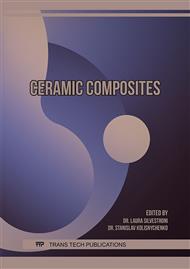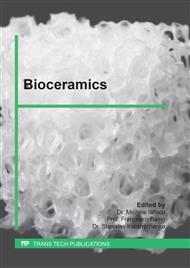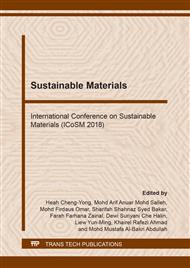p.58
p.65
p.71
p.76
p.83
p.90
p.96
p.102
p.109
Preparation and Characterization of Macro Porous Glass-Ceramics as Bioactive Scaffold Material
Abstract:
Bioactive glass and glass-ceramics have a huge interest in biomedical application due to their high biocompatibility and bioactive property. In this study, macro porous glass-ceramic based on 51.26% SiO2 - 36.56% CaO - 11.83% P2O5 and 42.11% SiO2 - 18.42% CaO - 29.82% Na2O - 9.65% P2O5 (in mol%) were prepared via sol-gel synthesis and powder sintering method. Sodium nitrate was used as the precursor for sodium oxide (Na2O) composition in the sol-gel glass. Effect of sodium nitrate addition on the sintered glass (glass-ceramic) properties were studied. The stabilized gel-glasses obtained were compacted into pellets and sintered at 1000 °C for 3 hours. It was found that, Na-contained glass-ceramic (Na-GC) crystallized at 71.5% due to increase in sodium-related crystalline phases. Na-GC showed 72.98% of apparent porosity and densified at 27.02% with macro porous structure with pore sizes in the range of 22.4 μm to 302 μm. The macro porous structure of Na-GC was obtained due to the foaming effect occurred during sintering. Flux effect occurred during sintering also resulted in relatively high compressive strength of Na-GC at 21.53 MPa. The macro porous Na-GC also proved to be bioactive as apatite-like structures were deposited on its surface after immersed into SBF solution for 14 days. The prepared macro porous Na-GC has high potential to be used as a scaffold material in biomedical application due to combination of suitable macro-pore size range, bioactive and has sufficient mechanical strength.
Info:
Periodical:
Pages:
83-89
Citation:
Online since:
August 2018
Keywords:
Price:
Сopyright:
© 2018 Trans Tech Publications Ltd. All Rights Reserved
Share:
Citation:




